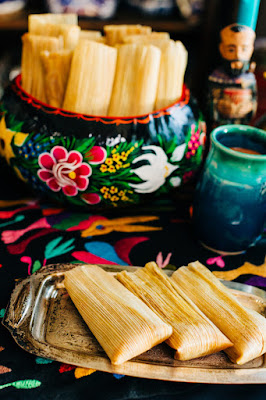Postales del Paraiso
Abuelinda's Cooking School
It’s a Mexican history lesson, it’s a cultural emersion course, it’s a health seminar, an international economics tutorial, an anthropology lesson, a culinary shopping experience, and it’s a cooking class!
Linda has been cooking in Latin America and the Caribbean for 35 years, and the classes that she offers are an astonishing mix of everything she’s encountered during that time. Every Wednesday she offers a “Tianguis to Table” class which starts in the local open air street market called the tianguis (tay-yán-gays) learning about and selecting local fruit, vegetables, Mexican foods, and then returning to Abuelinda’s kitchen and preparing a meal. She also offers classes from the culinary worlds of Chiapas, Oaxaca, Veracruz, Puebla, all unique, all fascinating.
We started early one morning at the local tianquis where blue plastic tarps tethered haphazardly to trees and each other arc low over the jostling crowds. The rows of tables that line the cobblestone streets feature beautifully crafted corn-husk dolls, excruciatingly detailed beadwork by the local Huichol Indians, magnificent woolen shawls and clothing from the highlands outside of Chiapas, homeopathic remedies, and an astonishing array of fruits, vegetable, meats, fish, cheeses. Queso fresco and panela cheeses, spiny nopal cactus, plump blueberries, roasted garbanzo beans, natural pig skin pickled in vinegar (cueritos), or fried (chicharrón), candied quince, fresh fish, chickens, flowers, The variety is endless!
We bought ingredients for our afternoon menu of Chiles en Nogada, deep green poblano chilies, a pork shoulder, plump raisins, dried mango, candied bisnaga cactus, pears, apples, peaches, plantains, Mexican canela, pomegranates, Queso de cabra, walnuts, rice, the list goes on.
But it was in Abuelindas kitchen that the real magic happened. We were each guided through an assigned a task, charring the poblanos over an open flame, dicing the pork, mixing and grinding spices in a molcajete (volcanic rock mortar & pestle), chopping fruits, seeding pomegranates, all accompanied by a running commentary and explanation of our many unfamiliar ingredients, and delightful stories about the cultures and cuisines of Mexico.
And then the best part. We got to enjoy the fruits of our labors. The roasted, smoky, earthy flavor of the poblano chile is the essence of Mexico, and when stuffed with the warm picadillo filling of diced pork, fruits, nuts, herbs, and spices, covered in a cool, creamy walnut sauce, and sprinkled with tangy, tart, pomegranate seeds, the result is simply heaven! I could eat this every day of my life!
















